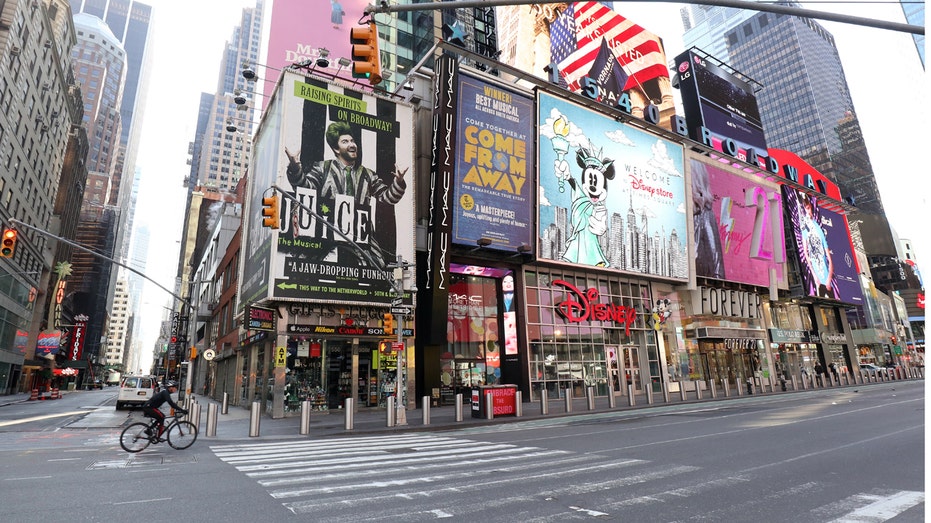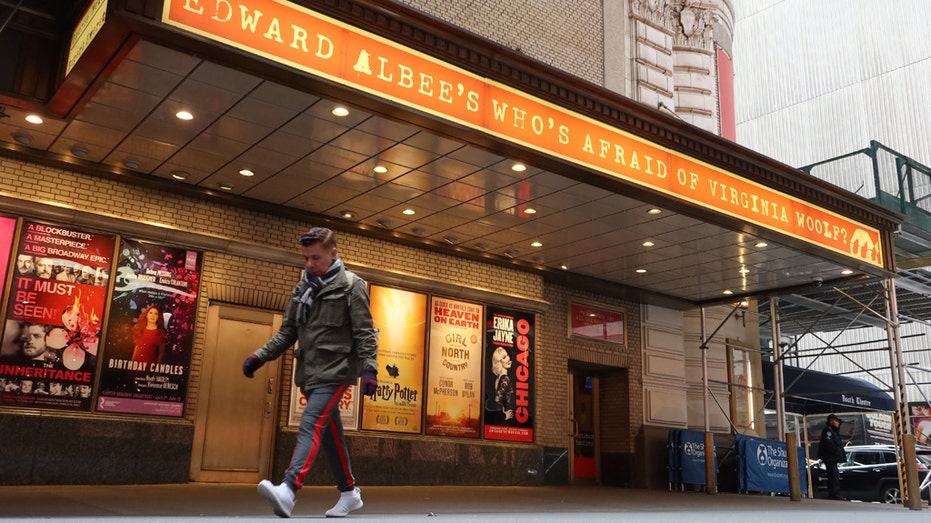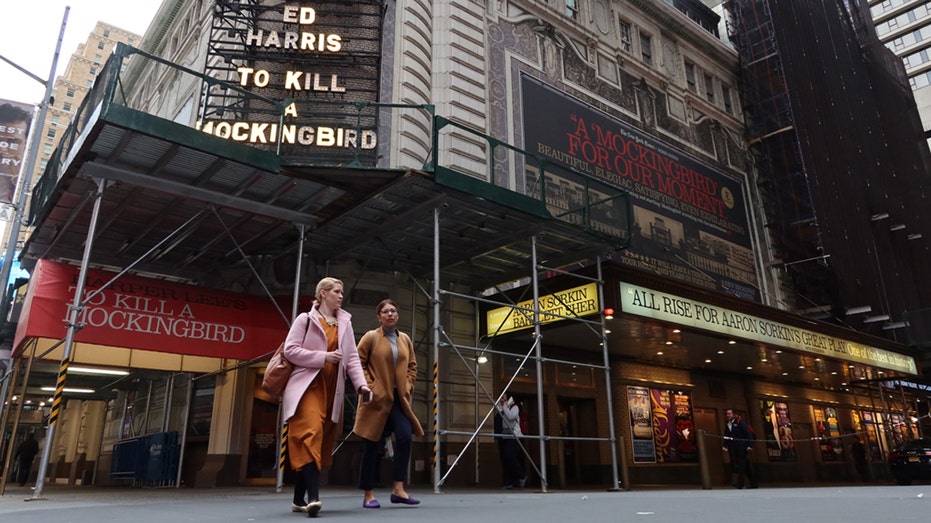Coronavirus leaves New York City artists in a ‘tailspin’
"These are the people who fall through the cracks when something like this goes down"
NEW YORK — Dancer and choreographer Netta Yerushalmy has built a career in movement and community. Both are gone now. Her world is still, isolated and fearful.
“Dancers I know are in a muted, depressed state right now,” she said from her apartment in Manhattan. “The metaphor of the caged beast is pretty apt.”
Across the city, the pandemic has upended almost everyone’s lives, but the arts community — the dancers, actors, visual artists and designers, who never made much income to start with — is especially suffering, imperiling New York City as a creative capital.

NEW YORK, NY - MARCH 26: A person cycles on 7th Avenue through the deserted Times Square as coronavirus (COVID-19) stay at home orders have kept most people off the streets of Manhattan on March 26, 2020 in New York City. Gary Hershorn/FOX News
“There are people who were already struggling, who are now in dire situations,” said Stacy Tenenbaum Stark, executive director of The Foundation for Contemporary Arts. “Most performing artists have a very precarious life as it is. They’re really working from project to project.”
Data from the city’s dance world paint a harrowing picture. Of 984 independent dance workers responding to a recent survey, 63 percent reported cash flow issues and 76 percent needed funds for their mortgage or rent. The average total income of respondents was $33,205.
“People can’t pay for their groceries. They can’t buy food. Only about half of them can apply for unemployment,” said Alejandra Duque Cifuentes, executive director of Dance/NYC, which conducted the survey and serves 5,000 dance artists.
The picture is hardly better across other parts of New York City’s creative sector, which employs over 293,000 people and accounts for $110 billion in economic activity.
Steve Jordan, the co-artistic director of the Jazz Foundation of America, said the shutdown has been “completely devastating” for jazz musicians.
“They really define the gig economy," he said." These are the people who fall through the cracks when something like this goes down."
Losing a nightly paycheck is only part of it. Like many public school kids who rely on school meals, jazz musicians often depend on a club’s complementary dinner. So it was a double hit.
“It’s more complicated than just, ‘Oh, we’ve had a couple of tours canceled that will be rescheduled,’“Jordan said. “We’re talking about people who virtually live from gig to gig.”
APPLYING FOR GIG WORK DURING CORONAVIRUS: WHAT TO KNOW
The theater community is also hurting. A.R.T./New York projected that more than 400 member theaters will suffer a $140 million in a projected loss. Randi Berry, executive director of The Indie Theater Fund, said the pandemic has put the theater community into an “absolute tailspin.”
“While I totally understand that this problem is going to be felt from the top to the bottom, from the left and the right, you already had a group of marginalized artists within a marginalized community,” she said. “Any slip-up is devastating.” She has been helping despite having COVID-19 symptoms herself.

NEW YORK, NY - MARCH 12: A man walks past the Booth Theatre after it was announced Broadway theatres will close for a month on March 12, 2020 in New York City. (Photo by Gary Hershorn/Getty Images)
The moment the city shut down, arts officials knew social distancing measures were necessary but would come at a very high cost — not just postponed recitals and shows, but side gigs that artists rely on to supplement incomes, like yoga classes, babysitting, retail shifts.
Congress’ $2.2 trillion federal relief package included a big boost to unemployment insurance benefits that allow more people to qualify, but it tops out at $504 in New York. Everyone on the unemployment rolls will also get an additional $600 a week until July 31.
CORONAVIRUS STIMULUS PHASE 4 COULD EXCEED $1 TRILLION AND INCLUDE NEGATIVE PAYROLL TAX
But many artists aren’t on the rolls and some spent years developing their work, often sinking their own money into it — all snatched away when the venues closed.
“I don’t know how these artists recoup their seasons and recoup the money they’ve probably spent on studio time, paid to rehearse dancers, paid costume designers and for sets,” said Stark.
Cifuentes contrasts the pandemic to other shocks to the system, like Superstorm Sandy and 9/11. In those other events, though, their beginning and end were clear.
“Right now we are in the middle of something that is ongoing," she said. "There is uncertainty that comes with it. There is no full understanding of how long it will last."
BROADWAY EXTENDS CORONAVIRUS SHUTDOWN THROUGH JUNE
“This crisis has the potential to shutter the doors of some of the most vital cultural organizations in our city that have made New York City what it is,” Cifuentes said.

NEW YORK, NY - MARCH 12: People walk past the Shubert Theatre after it was announced Broadway theatres will close for a month on March 12, 2020 in New York City. (Photo by Gary Hershorn/Getty Images)
Fundraisers are being held for artists and foundations have scrambled to award grant money, especially since history shows such crises disproportionately effect artists of color, disabled artists and LGBTQ artists.
The Indie Theater Fund has funded about 200 grants and received 700 applications, exhausting all of its $90,000 in emergency funds. Dance/NYC was recently overwhelmed with requests for aid: 653 grant applications came in over five days and there was only enough money to award 180.
“The need is greater than the resources,” said Cifuentes.
HOW SMALL BUSINESSES HIT BY CORONAVIRUS CAN GET AID
The long-term fear is that artists will abandon the city if they are abandoned by the city, taking away what makes New York City such a magnet for creativity.
Acting Commissioner of Cultural Affairs Kathleen Hughes said she’s struck by the resilience of the arts community. She thinks the city needs artists as much as they need the city.
“The way I’ve been thinking about it lately is that we’re all going to need them. And if we need them, then we have to be there for them,” she said.
Many artists like Yerushalmy have turned to social media to get their work out, posting music and artwork on Instagram. And many venues are streaming performances and artist talks.
CORONAVIRUS-INDUCED ECONOMIC DOWNTURN SEES WEALTHY CASHING IN ON ART, MEMORABILIA
Yerushalmy is streaming her six-part multidisciplinary work “ Paramodernities Live ” from May 4-9 starting at the same time each day with live post-show discussions that will disappear after a few hours.
“We’re trying to figure out what are the things that preserve that sense that we’re all here now together doing something together,” she said. “It’s so hard to be in this infinite limbo.”
Even when this crisis subsides, artists and administrators are haunted by the fear that people will no longer want to gather in crowds again for plays, dances and concerts.
“There’s certainly going to be a lot of fear among audience-goers to go back into a concert hall or theater venue. There’s going to be a lot of hesitation,” said Stark.
To keep art alive in the city “it will be the bravery of going back.”




















